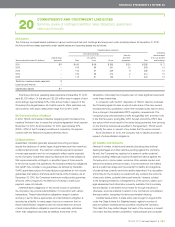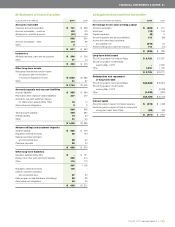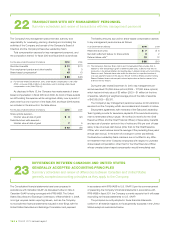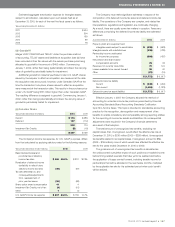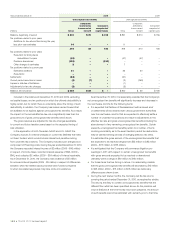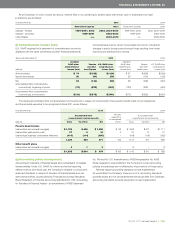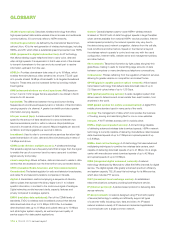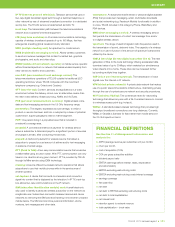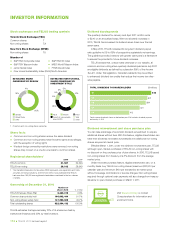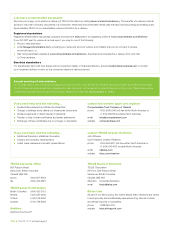Telus 2010 Annual Report Download - page 175
Download and view the complete annual report
Please find page 175 of the 2010 Telus annual report below. You can navigate through the pages in the report by either clicking on the pages listed below, or by using the keyword search tool below to find specific information within the annual report.
TELUS 2010 annual report . 171
MANAGEMENT’S DISCUSSION & ANALYSIS: XGLOSSARY
IP TV (Internet protocol television): Television service that uses a
two-way digital broadcast signal sent through a switched telephone or
other network by way of streamed broadband connection to a dedicated
set-top box. The TELUS service is trademarked as Optik TV.
local loop: The transmission path between the telecommunications
network and a customer’s terminal equipment.
LTE (long-term evolution): A 4G mobile communications technology,
capable of wireless broadband speeds of up to 100 Mbps, that has
emerged as a leading global wireless industry standard.
MDU (multiple dwelling unit): An apartment or condominium.
MMS (multimedia messaging service): Allows wireless customers
to send and receive messages that contain formatted text, graphics,
photographs, and audio and video clips.
MVNO (mobile virtual network operator): A mobile service operator
without licensed spectrum or network that leases wireless capacity from
other carriers to resell to end customers.
non-ILEC (non-incumbent local exchange carrier): The
telecommunications operations of TELUS outside its traditional ILEC
operating territories, where TELUS competes with the incumbent
telephone company (e.g. Ontario and Quebec).
OTT (over-the-top): Content, services and applications in a video
environment where the delivery occurs over an alternative means than
the main video delivery infrastructure (e.g. Netflix and YouTube).
PCS (personal communications services): Digital wireless voice,
data and text messaging services in the 1.9 GHz frequency range.
penetration: The degree, expressed as a percentage, to which a
product or service has been sold into or adopted by a base of potential
customers in a given geographic area or market segment.
POP: One person living in a populated area that is included in
a network’s coverage area.
postpaid: A conventional method of payment for wireless service
where a subscriber is billed and pays for a significant portion of services
and usage in arrears, after consuming the services.
prepaid: A method of payment for wireless service that allows a
subscriber to prepay for a set amount of airtime and/or text messaging
in advance of actual usage.
PTT (Push to Talk): A two-way communication service that works like
a walkie-talkie using a button switch. With PTT, communication can only
travel in one direction at any given moment. PTT is provided by TELUS
through its Mike service using iDEN technology.
roaming: A service offered by wireless network operators that allows
subscribers to use their mobile phones while in the service area of
another operator.
set-top box: A device that connects to a television and converts a
signal into content that is displayed by the television. In IP TV, a set-top
box allows two-way communications on the IP network.
SIM (subscriber identification module) card: A small electronic
chip used to identify a particular wireless subscriber on the network as
a legitimate user. Subscribers can switch between devices and carrier
networks by removing the SIM card and inserting it into another unlocked
mobile device. The SIM card can store personal information, phone
numbers, text messages and other data.
smartphone: An advanced mobile device or personal digital assistant
(PDA) that provides text messaging, email, multimedia downloads
and social networking (e.g. Facebook Mobile) functionality in addition
to voice. TELUS includes in this category iPhone, BlackBerry and
PDA devices.
SMS (short messaging service): A wireless messaging service
that permits the transmission of a short text message from and/or
to a digital wireless device.
spectrum: The range of electromagnetic radio frequencies used in
the transmission of sound, data and video. The capacity of a wireless
network is in part a function of the amount of spectrum licensed and
utilized by the carrier.
VDSL2 (very high bit-rate digital subscriber line 2): The next
generation of fibre to the node technology offering accelerated data
download rates of up to 30 Mbps, which enables four simultaneous
video streams into a home. These rates can be increased further
by bonding multiple lines together.
VoIP (voice over Internet protocol): The transmission of voice
signals over the Internet or IP network.
VPN (virtual private network): A private data network that makes
use of a public telecommunications infrastructure, maintaining privacy
through the use of a private secure network and security procedures.
Wi-Fi (wireless fidelity): The commercial name for networking
technology that allows any user with a Wi-Fi-enabled device to connect
to a wireless access point (e.g. hotspot).
WiMax: A standards-based wireless technology that provides high
throughput broadband connections over long distances. Currently,
WiMax in Canada is licensed for fixed rather than mobile service in
the 2.5 GHz spectrum band.
FINANCIAL DEFINITIONS
See Section 11 of Management’s discussion and
analysis for:
.ARPU (average revenue per subscriber unit per month)
.churn per month
.cost of acquisition (COA)
.COA per gross subscriber addition
.dividend payout ratio
.EBITDA (earnings before interest, taxes, depreciation
and amortization)
.EBITDA excluding restructuring costs
.EBITDA excluding restructuring costs interest coverage
.earnings coverage
.free cash flow
.net debt
.net debt to EBITDA excluding restructuring costs
.net debt to total capitalization
.net interest cost
.retention spend to network revenue
.total capitalization − book value


